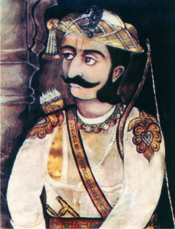Raghuji the Great
Raghuji I (Raghuji Bhonsle, mr; 1695 – 14 February 1755)[1][2] was a Maratha general who is credited with the Maratha expansion into Gondwana, Odisha, and Bengal, thereby establishing Maratha supremacy in these areas. He was granted the title of Senasaheb Subha, meaning "Lord of the Provinces and the Army," along with a saranjam in the Vidarbha region by Shahu I. He is regarded as the founder of the Kingdom of Nagpur.[3]
| Raghuji the Great | |
|---|---|
| Senasaheb Subha[lower-alpha 1][4] Senadhurandhar[lower-alpha 2] | |
 Portrait of Raghuji Bhonsle | |
| 1st Raja of Nagpur | |
| Reign | 1739 – 14 February 1755 |
| Predecessor |
|
| Successor | Janoji I |
| Born | Raghuji Bhonsle c. 1695
|
| Died | 14 February 1755 (aged 69–70)
|
| Issue | Janoji I Mudhoji | Bimbaji Sabaji |
| House | Bhonsle (Nagpur) |
| Father | Bimbaji |
| Mother | Kashibai |
| Religion | Hinduism |
Origin[edit | edit source]
The Bhonsale family branch of Raghoji were known as Hinganikar as they were originally chiefs from Berdi near Hingani in Pune District established by Bimbaji Bhonsle. Raghoji's great-granduncle Rupaji I, great-grandfather Mudhoji and grandfather Bapuji with two brothers Sabaji and Parsoji had fought in the armies of Shivaji. Mudhoji resided in Pandavgad, ruling over a Mauza near Wai in Maharashtra, which Shivaji had granted to him as Jagir for his spectacular exploits, while his brother Rupaji I resided at Bham in the district of Yavatmal.[5]l
Rupaji I was childless therefore his property also passed over to Raghoji's great-grandfather Mudhoji which gave Hinganikar Bhonsles a foothold in east Maharashtra for future conquests. Chhatrapati Shivaji entrusted high military command and the collection of chauth (tribute) in Berar to the most distinguished of them. Mudhoji's son Sabaji was given villages of Rakhswari and Poorkikotar however it was Parsoji who attained highest position in the family.
During Mughal-Maratha Wars the title of Senasahibsubha (meaning Master of provinces and armies) was bestowed on Parsoji Bhonsle by Chhatrapati Rajaram Bhonsle along with rights to regions of Devgad, Gondwana, Chanda and Varhad from where he could exact tribute. Bapuji only had one son Bimbaji who was the father of Raghuji I. Parsoji had three sons; Santaji, Kanhoji and Ranoji each with a distinguished career. Santaji was part of various campaigns of Chhatrapati Shivaji and the other commanders, till his murder in Delhi during the 1719 campaign to depose Farrukhsiyar led by Senapati Khanderao Dabhade. Ranoji was given title of Sawai Santaji (meaning Superior Santaji) along with other compensations for the loss of his brother's life.
In 1722, Shahu I presented Badnera and Amravati to Ranoji Bhonsle, further extending presence of Hinganikar Bhonsles in east. Kanhoji went on to secure the family title of Senasahibsubha and paved the way for future conquests by ruling for 20 years. The lesser prominent Bimbaji Bhonsle was without a son until one was finally born, who Bimbaji believed to be a result of prayers of a pious Vaishnava saint Ramajipant Kolhatkar. On those grounds Bimbaji named his son Raghuji (Raghava) after the avatar of Vishnu Rama.[6][7]
Early life[edit | edit source]
Bimbaji died shortly after his son was born, and Raghuji grew up with his mother Kashibai and grandmother Baijabai at the same Pandavavadi near Wai. On attaining maturity Raghuji served under his uncle Ranoji as a Shiledar (cavalryman) at Amravati, participating in various military operations.[8] His uncle Senasahibsubha Kanhoji Bhonsle based at Bham, sixteen miles south of Yavatmal, invited him to his fief as he was heirless up to that point.
City of Bham or Bhambraja, was located on a small plateau near the Adan river, raised 300 ft. above the level of the valley. It is a vast but completely abandoned site of immense stone ruins and traces of planted trees. The expanse of the original settlement could be imagined by the traditions of 5,000 houses owned by Bairagis (ascetics) alone under the protection of Marathas.[9] Senasahibsubha Kanhoji looked after and mentored Raghuji, who was the son of his cousin Bimbaji, with hopes of gradually passing his duties to him. But after the birth of his son Rayaji Bhonsle, his plans for adopting Raghuji ended and their relations were disrupted.[10]
Death and legacy[edit | edit source]
King of Nagpur Raghuji Bhonsle died on February 14, 1755. Six wives and seven concubines of Raghuji Bhonsle are said to have immolated themselves on his funeral pyre. Other chronicles record 8 of his 13 wives and innumerable concubines conducted Sati. He left behind four legitimate sons Janoji, Mudhoji, Sabaji and Bimbaji and one known natural son Mohansingh.
Notes[edit | edit source]
Reference[edit | edit source]
- ↑ The Cyclopedia of India: Biographical, Historical, Administrative, Commercial. Book Traders. 1992. p. 312.
- ↑ Mishra, Prabhu Lal (1979). The Political History of Chhattisgarh, 1740-1858 A.D. Vishwa Bharati Prakashan. pp. 38, 39, 88.
- ↑ Daniyal, Shoaib (2015-12-21). "Forgotten Indian history: The brutal Maratha invasions of Bengal". Scroll.in. Retrieved 2024-07-18.
- ↑ Vaidy, Sankara (7 April 2024). "Vaidya-daptarantuna Nivadalele Kagada".
- ↑ Congress, Indian History (1975). Proceedings. Indian History Congress. p. 311.
- ↑ "Maharashtra state Gazetteer district Nagpur". gazetteers.maharashtra.gov.in.
- ↑ Maratha Generals and Personalities: A gist of great personalities of Marathas. Pratik gupta. 2014-08-01.
- ↑ Malik, Zahiruddin (1975). "Side Lights on the Administrative System of the Bhonsle State of Nagpur (1740-1772)". Proceedings of the Indian History Congress. 36: 310–320. ISSN 2249-1937. JSTOR 44138856.
- ↑ Maharashtra (India) (1960). Maharashtra State Gazetteers: Ahmadnagar. Directorate of Government Print., Stationery and Publications, Maharashtra State. p. 698.
- ↑ Maharashtra State Gazetteers: Akola. Director of Government Printing, Stationery and Publications, Maharashtra State. 1977. p. 139.
